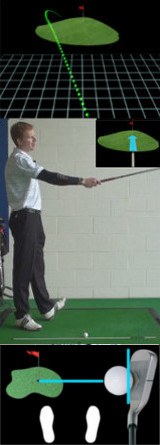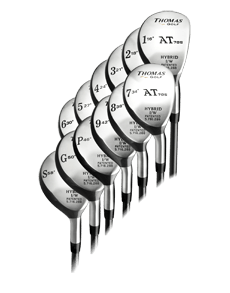Believe it or not, one of the hardest parts of making the transition away from a slice is figuring out how to use your new, straighter shots on the course. This might seem like a good problem to have, and it is, but it’s still something you’ll need to overcome at some point.
For this section, we are going to assume you have done all the hard work necessary on the driving range to eliminate your slice. So, will everything go great when you play your first round after making these swing changes? Probably not. Hopefully, the following techniques will help to smooth out the bumps.
- Pay close attention to your aim. If you have been playing with a slice for a while, you have probably adjusted to aim out to the left of the target. This is natural, as your ball has been curving badly to the right. Now that your slice is gone, you are going to have to pay close attention to make sure you are actually aiming properly.
- You don’t necessarily want to aim right at the target – you probably still have some kind of curve on your shots – but you shouldn’t need to aim as dramatically left as you were before. Think about the expected trajectory for each shot and aim accordingly.
- Learn new distances. One of the overlooked elements of the slice is the fact that it tends to rob the player of a significant amount of distance. As your ball flight straightens out, your shots are almost certain to fly farther. Since it is nearly impossible to gauge your distances on the driving range, it is going to take a few rounds out on the course to get used to your new yardages.
- Building trust. Simply put, you probably won’t trust your new ball flight at first. This is especially true for golfers who have been fighting with a slice for years. You are used to seeing the ball take off and quickly turn to the right – and you can’t just wipe out all of those memories. As you play your rounds, think about the work you’ve done on the range, and try to draw confidence from those experiences. With any luck, you’ll soon forget about your slice and fully trust your new pattern instead.
It is frustrating to deal with a slice, but you don’t need to just throw up your hands and give in. With a plan and plenty of work on the range, you should be able to gradually work toward straighter shots. We hope the information provided in this article will help you make progress toward your goals,
Making a swing change and experiencing gradual improvements on the golf course! Making adjustments to your swing can be a challenging process, but it's great to hear that your hard work is paying off. Here are a few points to consider as you continue to refine your swing and make progress:
- Patience and Persistence: It's important to stay patient throughout the process. Changing your swing takes time, and results may not be immediate. Remember that every golfer progresses at their own pace, so focus on the positive improvements you're making rather than comparing yourself to others.
- Practice with Purpose: Continue to practice with a purposeful approach. Break down your swing into smaller components and work on them individually. Focus on specific areas that need improvement and incorporate drills or exercises that target those aspects. Regular and consistent practice will help solidify the changes in your muscle memory.
- Seek Professional Guidance: Consider seeking guidance from a golf instructor or coach. They can provide valuable insights, identify any lingering swing flaws, and offer specific drills or exercises tailored to your swing. Professional guidance can help expedite the learning process and ensure you're on the right track.
- Course Management: As you continue to refine your swing, it's essential to develop good course management skills. Understand your strengths and weaknesses and adjust your strategy accordingly. For example, if you've improved your accuracy but lost some distance, focus on playing smart shots that maximize your strengths rather than taking unnecessary risks.
- Mental Approach: Golf is as much a mental game as it is a physical one. Maintain a positive mindset and trust in the changes you've made to your swing. Avoid getting too fixated on your score or individual shots. Instead, focus on the process, stay present, and make the best decisions on each shot.
- Track Your Progress: Keep a record of your rounds and monitor your progress over time. Documenting your scores, fairways hit, greens in regulation, and other relevant statistics will help you gauge your improvement objectively. It will also give you a sense of accomplishment as you see your numbers improve over time.
Remember, golf is a journey, and swing changes are a natural part of the game. Embrace the process, stay dedicated, and enjoy the incremental improvements you're experiencing.
Update:
After a Swing Change: Gradual Improvements on the Course
- Increased Consistency:
- One of the first signs of improvement is often increased consistency in ball-striking. A more reliable and repeatable swing leads to better contact with the ball.
- Improved Accuracy:
- As the golfer becomes more comfortable with the new swing mechanics, there's a potential for improved accuracy. The ability to control the clubface and path contributes to hitting desired targets.
- Better Shot Shaping:
- Golfers may notice improvements in their ability to intentionally shape shots. A refined swing allows for better control over fades, draws, and straight shots.
- Distance Gains:
- While the primary goal of a swing change may not be focused on distance, improved mechanics can lead to more efficient energy transfer, resulting in potential distance gains.
- Reduced Misses:
- The occurrence of significant misses or errant shots may decrease. A more stable and consistent swing minimizes the likelihood of extreme mishits.
- Confidence Boost:
- Gradual success on the range and during practice rounds contributes to increased confidence on the course. Confidence plays a crucial role in making successful swings under pressure.
- Easier Recovery from Mistakes:
- Golfers may find it easier to recover from mistakes during a round. The ability to self-correct and maintain composure improves as the new swing becomes more ingrained.
- Adaptability to Course Conditions:
- Golfers may become more adaptable to various course conditions. The refined swing allows for better decision-making and shot execution in different situations.
- Consistent Ball Flight:
- A more stable swing often leads to a more consistent ball flight. Predictable ball flight patterns contribute to better course management.
- Lower Scores:
- As the golfer becomes proficient with the new swing, the potential for lower scores increases. Improved ball-striking and shot-making directly impact overall performance.
10 Q&A on After a Swing Change: Gradual Improvements on the Course
- Q: How long does it take to see improvements after making a swing change?
- A: The timeframe varies, but golfers often see initial improvements in ball-striking within a few weeks. Full integration and comfort with the changes may take several months.
- Q: Can a swing change affect short game performance?
- A: While the primary focus may be on the full swing, changes in mechanics can have a ripple effect on overall performance, including the short game.
- Q: Should golfers expect setbacks during the transition to a new swing?
- A: Yes, setbacks are common. Golfers may experience periods of inconsistency as they adjust to the changes. Consistent practice and reinforcement are crucial.
- Q: How can golfers maintain confidence during the transition phase?
- A: Positive reinforcement, focused practice, and acknowledging small successes contribute to maintaining confidence during the transition.
- Q: Is it necessary to work with a golf instructor during a swing change?
- A: While some golfers successfully make swing changes on their own, working with a qualified instructor provides personalized guidance and feedback.
- Q: Can a new swing lead to changes in equipment, such as club fitting adjustments?
- A: Yes, changes in swing mechanics may warrant adjustments in equipment, including club length, lie angle, or shaft flex. A club fitting session can be beneficial.
- Q: How can golfers track progress during a swing change?
- A: Keeping a practice journal, recording swing videos, and tracking on-course performance are effective ways to monitor progress.
- Q: Should golfers focus on one change at a time or make multiple adjustments?
- A: It's often recommended to prioritize one change at a time to avoid overwhelming adjustments. Mastering one aspect before moving to the next is a common approach.
- Q: Can physical conditioning complement a swing change?
- A: Yes, physical conditioning, including flexibility and strength training, can support the transition to a new swing by enhancing overall athleticism.
- Q: What role does mental preparation play in adapting to a new swing?
- A: Mental preparation is crucial. Visualization, positive self-talk, and a patient mindset contribute to successfully adapting to a new swing.
Remember that every golfer's journey is unique, and the key to successful swing changes is dedication to practice, patience, and a willingness to learn and adapt. Seeking guidance from a golf instructor and maintaining a positive attitude are essential components of the process.

 Believe it or not, one of the hardest parts of making the transition away from a slice is figuring out how to use your new, straighter shots on the course. This might seem like a good problem to have, and it is, but it’s still something you’ll need to overcome at some point.
Believe it or not, one of the hardest parts of making the transition away from a slice is figuring out how to use your new, straighter shots on the course. This might seem like a good problem to have, and it is, but it’s still something you’ll need to overcome at some point.



